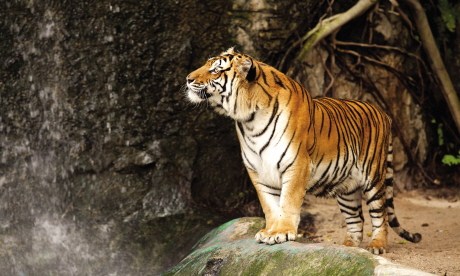
In some parts of the world, tiger tourism is big business – here’s how to see them in the wild without doing them harm
Last week, Wanderlust reported that Nepal's tiger population has grown. With the good news in mind, Chris Pitt reveals how YOU can see tigers in the wild in a way that won't affect them.
Seeing a tiger in the wild is a dream for many, a reality for a few, and a pain in the backside for the tigers… Well, tigers were doing pretty well without humans for a long time so it’s likely they’d rather be left to their own devices.
That, however, is not going to happen. Humans have invaded their space and won’t be going away – so the next best thing has to be to co-exist peacefully, and respectfully. But what does that mean in terms of tourism?
In most cases, tourism can be good for wild tigers, pulling in revenue for their conservation that is desperately needed with only 3,200 remaining worldwide. In India, it’s fair to say that the areas with the highest numbers of these amazing animals are the ones that support both tourism and tigers. Why? For various reasons, including the simple fact that it’s hard to poach a tiger if a bus-load of tourists is parked behind you. The more tourists there are to protect the tigers, the less chance they'll have of being poached.
Using the above example, though, having jeeps full of tourists trawling through the jungle isn’t great for the tigers either. To be honest, it’s not going to be good for the visitors too – as the loud noises and constant invasions will see tigers hiding away.
Alternatively, elephant-trekking can be a popular and more natural way of getting in among the trees. However, you need to be careful which companies you take a tiger safari with. In parts of Asia, the method used to train elephants to carry people is nothing less than brutal. Find a reputable company and enquire about the way in which they train their animals, if you're concerned. Also find out where their elephants came from: where they taken form the wild or raised as orphans? Answering these questions will help you join a more worthwhile cause.
There’s a move in India, as in other parts of the world, towards less invasive, or destructive, ways of seeing tigers and other jungle-dwelling animals. Sitting on a viewing platform or strolling through the jungle in search of a tiger may fill some with fear – but hey, you are trying to see a wild animal in its own territory! Seriously, there are increasing amounts of good walking tours run by experienced guides who will immerse you in the habitat.
Heading to ‘priority’ reserves may lessen your chances of seeing a tiger, but you will be supporting the local community and, in effect, the conservation of the tigers. The thrill of going on a ‘tiger hunt’, searching for clues (eg ‘pug’ marks), talking to villagers about their experiences and so on is going to be something you never forget – whether you see a tiger or not.
Check out your hotel too – is it contributing to the local economy, or is it a drain on resources (eg swimming pools, bright lights, noisy parties)?
For those who aren’t able to get to the jungle (and most of us can’t), how do we get our tiger fix?
One popular visitor destination is The Tiger Temple in Kanchanaburi, Thailand. Glossy photos in magazines show Buddhist monks raising tigers, and tourists getting up close to cubs. But the reality of places like this, as reported by Care for the Wild and others, is far from the glossy image.
A basic rule is that if a wild animal is performing non-natural behaviour, then someone has made it do that. The key message is do your research in order to make an informed decision before visiting controversial sites. Many feel that the wild really is the best place to see wild animals, and the only way we can make sure these rare opportunities exist is by protecting them and their natural habitat.